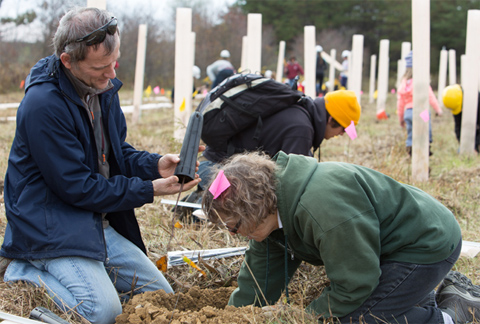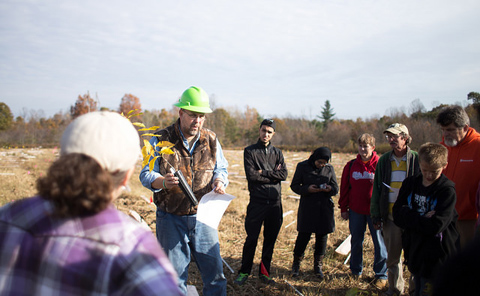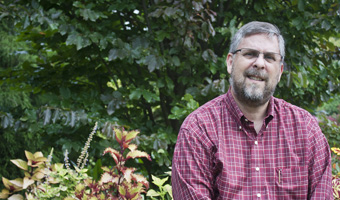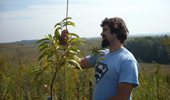
David Rosenthal, an assistant professor in the Environmental and Plant Biology Department at Ohio University, and Laura Caple, a retired teacher from Vinton County, plant an American chestnut tree seedling.
Photographer: Alexandria Polanosky
By McKenzie Powell
From Compass
Ohio University students and faculty spent a recent Saturday working with their counterparts from Hocking Technical College, Miami University, and volunteers from the community, U.S. Forest Service, the Ohio Department of Natural Resources, the National Wild Turkey Federation, and the American Chestnut Foundation on a project they’re hoping will help restore an ecological treasure to Ohio’s only national forest.
On Saturday, Oct. 25, nearly 90 volunteers planted approximately 750 American chestnut trees on Wayne National Forest property in Athens County. The project was sponsored by the U.S. Forest Service’s Wayne National Forest and Northern Research Station, the National Wild Turkey Federation and the Ohio chapter of the American Chestnut Foundation.
Dr. Brian McCarthy, Associate Dean of OHIO’s College of Arts & Sciences and an Environmental & Plant Biology Professor, serves as president of the Ohio chapter of the American Chestnut Foundation and sits on the American Chestnut Foundation’s board of directors. McCarthy was instrumental in not only organizing the Oct. 25 event but also in guiding volunteers through the planting process.

Brian McCarthy, associate dean of OHIO’s College of Arts and Sciences and an environmental and plant biology professor, explains how to remove American chestnut tree seedlings from their containers and how to plant them.
Photographer: Alexandria Polanosky
Known as the “redwood of the East,” the American chestnut tree once flourished in the eastern woodlands of the United States, stretching from Maine to Florida and including the Ohio Valley. This species of tree was valued not only as a vital food source for wildlife but also for its timber, which fueled rural economies.
A lethal fungus, known as chestnut blight, accidentally imported from Asia, infested American chestnut trees in the early 20th century. By mid-century, an estimated 4 billion mature American chestnut trees succumbed to chestnut blight.
The American Chestnut Foundation was established in 1983 with a goal of developing a blight-resistant American chestnut tree and restoring the tree to its native forests in the eastern United States. The Oct. 25 planting in Southeast Ohio’s Wayne National Forest was the latest attempt at reaching that goal.
“This is the first test going into Southeast Ohio,” explained McCarthy, who noted that the Oct. 25 planting included 30 different genetic variations of the American chestnut tree hybrid. “The American Chestnut Foundation has bred many different genetic lineages of American chestnuts, some of which appear to be resistant to the blight.”
According to McCarthy, the goal of the Oct. 25 tree planting is to see which of the genetic variations will be the most blight-resistant. The site where the trees were planted will be monitored to evaluate the trees’ blight resistance.
“In a way, what we’re doing is forced natural selection,” McCarthy explained. “But we’re doing it. It’s human-induced selection.”
While all of the participants shared a common desire to restore the American chestnut tree in Southeast Ohio, each also came to the event for their own personal reasons – be it to further their research, to network with other individuals who share their interests, or to set an example for today’s youth.
“I study American chestnuts, so I’m trying to get involved with the American chestnut programs in this area,” explained Bailey Hunter, an OHIO graduate student studying environmental and plant biology whose thesis is focused on the American chestnut tree. “There’s probably twice as many people than I thought was going to be here. I think it’s awesome because it shows that people care about the American chestnut. It’s a good sign that maybe there is hope.”
Dr. David Rosenthal, Assistant Professor of Environmental and Plant Biology at Ohio University, attended the event for both professional and personal reasons.
“Part of my research involves understanding the response of these hybrids to environmental stress,” Rosenthal said. “One of the reasons that we’re planting on this site is to understand which of the genotypes that resist the blight would be better for Ohio, or Vermont, or Georgia where the climates are different.”
Rosenthal said he will be monitoring the trees’ future growth and documenting their response to changes in the climate.
“Another reason I came is to demonstrate to my daughter what tree planting was about,” Rosenthal said while assisting his daughter with the planting. “She was very excited to come here and plant trees.”
Local forest conservation advocate Steve Stone shared Rosenthal’s passion for engaging youth in the process. A member of the American Chestnut Foundation and named Ohio’s Outstanding Tree Farmer of the Year in 2011, Stone participated in the tree planting with his mentee, sixth-grader Brandon Mayle.
Stone noted that efforts to restore the American chestnut tree go beyond planting trees or bringing the American chestnut back from near-extinction.
“Planting a tree is the ultimate statement of belief in the future. You plant a tree that people that you’ll never know may sit under someday,” said Stone. “A teacher’s influence never ends, even after the teacher ends. The people that they teach will carry on what they taught them and what they taught will live on forever, it’ll be passed on. It’s a way to ensure your own immortality – planting a tree and teaching somebody about it.”
Both McCarthy and Gary Chancey, public affairs officer and volunteer coordinator for the Wayne National Forest, noted the professional development opportunities the tree planting provided to the students who participated.
“This is a good way to meet people and network a little bit,” McCarthy said.
“We have people who are working for us now that graduated from Hocking College and Ohio University,” noted Chancey. “This is a great opportunity to get introduced to natural resource work in the field.”
Chancey also touted the strong partnerships that have been formed as a result of this project, saying “Everybody here has a common interest today; they care about the future of the American chestnut tree.”
And while only time will tell how successful the planting turns out to be, the event itself has certainly been deemed a success.
“The turnout is spectacular,” McCarthy said. “This is the largest turnout we’ve ever had for a tree planting in Ohio that we’ve done with the American Chestnut Foundation.”


















Comments